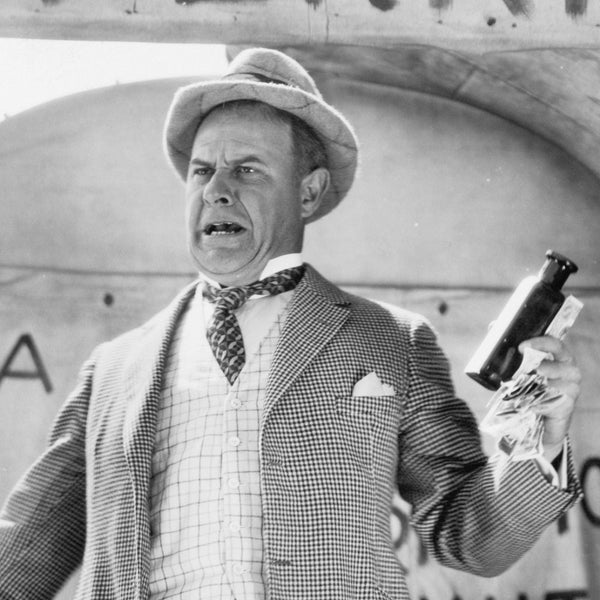Minoxidil - the first real treatment for hair loss
Over 50 years old and used by tens of thousands
Minoxidil is one of only two pharmaceuticals currently licensed by the US Federal Drug Administration as a treatment for hereditary hair loss. With a surprisingly long history, and after hundreds of studies and trials, it has a demonstrated ability to slow hair loss in the majority of cases, as well as actively promote regrowth in up to a third of cases. Given its long track record of results and safety, it is a powerful tool to help you keep your hair fit and healthy.
Discovered by accident when the only alternatives were “miracle-cures”
It's a sad reflection on the quackery that was the hair-loss “miracle cure” industry that when the first proper pharmaceutical treatment was discovered by accident, researchers actively downplayed it for fear of not being taken seriously. In the 1960s, researchers at Upjohn (now a part of Pfizer1) dismissed reports of hair thickening and regrowth in their clinical trials of new oral hypertension drug, Minoxidil, as an unimportant side effect. However, it was always going to be impossible to keep quiet that the new drug promoted hair growth, and a letter in the New England Journal of Medicine in 19802 finally acknowledged what was considered by then an "open secret".
Occupied with launching oral minoxidil for heart disease, Upjohn didn’t commence clinical trials of a topical version of the drug to combat hair loss until 1978, despite being deluged with volunteers. An initial placebo-controlled 6-month dose study3 of 0.01%, 0.1%, 1%, and 2% solutions showed significant increases in hair counts4 from solutions 0.1% and above, and clinically observable hair growth starting at 1% and above. Finally realising what they had on their hands, Upjohn moved to large-scale clinical trials in multiple centres across the United States5.
Hundreds of studies have demonstrated its effectiveness and safety
Since the initial research by Upjohn, there have been approximately 310 separate trials and studies into the efficacy and safety of Minoxidil6. In summation, the findings demonstrate that in excess of 80% of cases minoxidil will delay hair loss versus a placebo or non-treated case, and in slightly over 30% of cases, it will stimulate observable regrowth. The only side effect noted is local irritation of the scalp, which is correlated with increasing dose strength. For 2% strength topical solutions, this irritation was classed as moderate to severe in 6% of cases[^7]. When patients cease twice daily treatment their hair typical thins to a level similar to that of the non-treated or placebo groups within 48 weeks.
In a post-marketing surveillance study by Upjohn of in excess of 11,000 men and women who had been using minoxidil for a period longer than one year, 92% rated it as excellent, good or fair at stopping hair loss. Compliance with a twice daily regime appears to be the most significant factor in determining how well minoxidil works for a patient.
One of the most powerful tools to keep your hair fit and healthy
Minoxidil is the oldest and most studied FDA-approved pharmaceutical treatment hair loss for both men and women. It has a long history of proven effectiveness and safety with tens of thousands of people using it daily for over a decade. It has the proven ability to slow (and in a lucky third of cases roll back) early stage hair loss. The keys to using it effectively are to tune the dosage to the sensitivity of your scalp and maintain a safe and convenient application. At Men's Hair Fitness we are building on this successful history with a new subscription service that will deliver the marketing-leading minoxidil spray Regro to your door every month at a great price, see our treatments for details.
- Upjohn later merged with Pharmica in 1995 before being purchased by Pfizer in 2002 see http://www.wsj.com/articles/SB1026684057282753560
- Zappacosta AR. Reversal of baldness in a patient receiving minoxidil for hypertension. New England Journal of Medicine 1980;303:1480.
- Fenton DA, Wilkinson JD. Topical minoxidil in the treatment of alopecia areata. BMJ 1983;287:1015–7.
- Critically the new growth observed was in terminal (pigmented) hairs, not just the fine down like vellus hairs.
- Shupack JL, Kassimir JJ, Thirumoorthy T, Reed ML, Jondreau L. Dose-response study of topical minoxidil in male pattern alopecia. Journal of the American Academy of Dermatology 1987;16:673–6.
- Gupta AK, Charrette A. Topical Minoxidil: Systematic Review and Meta-Analysis of it’s Efficacy in Androgenic Alopecia.
Also in Research & News

Saw Palmetto - a natural way to reduce DHT
An alternative for Men who want to explore a more natural way of blocking DHT is Saw Palmetto. Widely used in the treatment of enlarged prostates, a condition closely hormonally linked to hair loss, there is good scientific evidence that it significantly reduces free DHT and thus protects your hair.
Learn how Saw Palmetto acts to reduce thinning by disrupting the production of DHT. This can have a powerful impact on its own or it can be used to enhance the effect of other treatments as part of a combined program.

What to expect from minoxidil treatment
In the short-term Minoxidil will halt further loss in 95% of men after 3 months of a twice-daily routine. Over a few months, 60% of men will report significant regrowth, especially for those that act quickly to stop the loss. After a year of continuous use, you should expect the initial gains to stabilize as you hair bounces back and you get the thinning under control.The key to using minoxidil is to get into and stick with a healthy routine to get on top of your hair and maintain your gains.

How to sell snake oil
The value of the global hair-loss treatment market is a $2.7bn USD in 2017, which is not surprising when you consider how widespread male pattern hair loss is. Unfortunately, a market that largely attracts not only serious research and clinically proven products, but also a host of more dubious “treatments” and, in some cases, completely unscrupulous “cures”. These can range from the seemingly well-intended but ineffective treatments to outright frauds.
